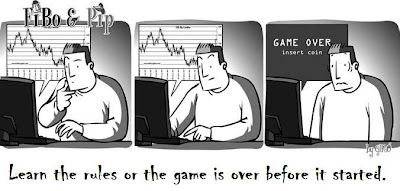People like to buy. That seems to simply be a fact of human behavior.
One of the things that most traders and investors look for are markets that are heading up and will continue going higher. I can no more tell the future than anyone on Wall Street, and my guess is that
your crystal ball is at the repair shop as well. So what can we do? Given the widespread preference for buying, the best thing to do is find a market where you can find a bull market no matter what. That’s the forex market.
This is where the U.S. dollar comes in.
The six most popular pairs in the forex market are either U.S. dollar–correlated majors or U.S. dollar–based commodity currencies also known as “comm dolls.” You didn’t think I was going to let you sound like a newbie now, did you?
Let’s briefly discuss the difference. U.S. dollar–correlated majors are the euro/U.S. dollar, the U.S. dollar/Japanese yen, the British pound/U.S. dollar, and the U.S. dollar/Swiss franc.
The four pairs trade against the U.S.dollar. The reason these are “correlated” is that the movements of these
pairs have a strong relationship to the U.S. dollar, which we can track with the U.S. dollar Index. We’ll talk in the next section about the relationships in detail, but for now keep in mind that the forex is a game of comparison.
Is the U.S. dollar gaining or losing ground to another nation’s currency?
If it seems as though I am spending an inordinate amount of time driving this point home it is because I think far too many traders forget that trading forex is a very tangible thing. It personally affects our everyday
lives and the everyday finances of corporations and banks. Our world and collective economies are not isolated, and the global economy is now more intertwined than ever. Anyone who for a moment bought into the theory that somehow the U.S. economy was dislocated from Europe, Asia, and the BRIC countries (Brazil, Russia, India, China) should now know different after witnessing a cataclysmic global slowdown. My point here is that forex, the relationship between different currencies, is at the heart of the worldwide
financial system and the more you understand this relationship the better overall trader you will become. Now who said forex trading couldn’t make you a better person?
FILL IN THE BLANKS
In case you’re new to forex, here’s the one line synopsis of what the foreign exchange market is: How many will I get for ?
How many yen will I get per U.S. dollar?
How many U.S. dollars will I get per euro?
So basically depending upon the strength or weakness of the U.S. dollar you may be able to get more or less of another currency in exchange. I think of it as the airport analogy. Let’s say we all jump on a flight to Paris
and upon landing we look to exchange our pocketful of U.S. dollars for euros. The forex rate will dictate what we get.
Traders and investors track, analyze, and use this price movement to determine whether they feel this rate will go higher or lower.
That brings us to commodity currencies or “comm dolls.” Maybe you have heard a little about what these pairs are and how they behave. My take is a little different, so let’s start with the basics. Generally speaking,
commodity currencies are just what their name would suggest: a currency pair that has a strong correlation back to a particular commodity. Simple, right? Well, not so fast.
The Australian dollar/U.S. dollar, New Zealand dollar/U.S. dollar, and U.S. dollar/Canadian dollar are the three pairs you will most commonly call “comm dolls.” Let’s use the U.S. dollar/Canadian dollar or “canada” as an example. The “canada” has a relationship to the energies complex, meaning crude oil, heating oil, natural gas. It moves, however, with a strong correlation to crude oil. Why? Well, consider that the country of Canada is one of the world’s leading exporters of crude oil (from www.eia.doe.gov/pub/oil gas/petroleum/data publications/company level imports/current/import.html).
You better bet the supply and demand of crude affects the Canadian economy. But is that the end of the story for commodity currencies? No, not even close. You see this pair has a correlation to the U.S. dollar as well.
Remember it’s the U.S. dollar/Canadian dollar pair. We not only have to consider the impact of crude oil on the Canadian dollar itself but also how the U.S. dollar is moving against the Canadian dollar.
I am going to go into great depth later on about these relationships and my Forex Market Pulse. For now, though, think about this: Does crude oil affect the Canadian economy alone? I think we have seen what high crude oil prices have done to the U.S. economy as well. So bottom line?
All pairs that have a relationship back to the U.S. dollar will have a certain amount of impact from crude oil. And that means that all U.S. dollar pairs can be considered comm dolls to a certain extent. Now that’s not something you will hear from most traders, but I’m here to tell you that’s the way it is.
All pairs that have a relationship back to the U.S. dollar will have a certain amount of impact from crude oil. And that means that all U.S. dollar pairs can be considered comm dolls to a certain extent. Now that’s not something you will hear from most traders, but I’m here to tell you that’s the way it is.
So, there’s always a bull market somewhere in the forex. When you consider all the different countries, commodities, and the relationship they have with one another, it’s easy to begin to understand that while some
currencies are being beaten down, others are rallying in comparison or are considered safe haven currencies. This is why you will always find that some pairs are heading lower while others are ripe for buying.

